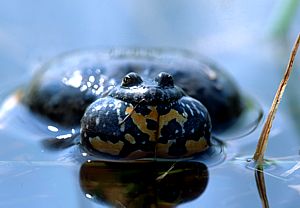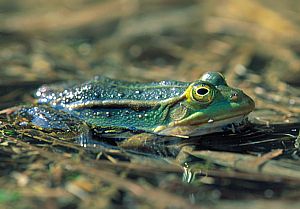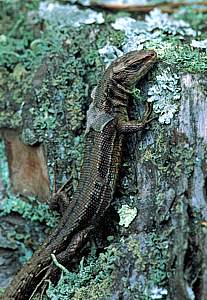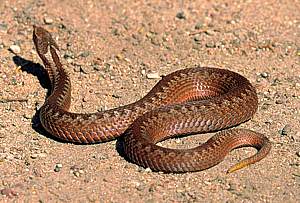|
PROTECTED FAUNA
|
|||||||||||
Text:
2003
|
Fishes, amphibians and reptiles
Fishes Pisces
In water bodies and continental rivers and in the Baltic Sea there are 89 fish species of all 419 fish species living in Europe. The Polish fish fauna was established about 12 thousand years ago, namely after the last glaciation and later on partially modified by man, who introduced the carp in the 12 th century. In accordance with the Decree of the Minister of Environment there are 27 fish protected species (25 species – strictly protected and 2 species under partial protection), in other words 30% of all the fish species living in Poland.
Up until now 31 fish species have been formally acknowledged to live in the waters of the Wigry National Park, which is almost 35% of all the Polish ichtyofauna. Four of them are strictly protected: the European minnows Phoxinus phoxinus, the bitterling Rhodeus sericeus, the spined loach Cobitis taenia, the weatherfish Misgurnus fossilis, and two are partially protected: the stone loach Noemacheilus barbatulus, and the belica Leucaspius delineatus.
The European minnows is found in small rivers and streams of clean water and a strong current. In the territory of the WNP it can be observed in the Czarna Hańcza and Kamionka Rivers. The bitterling lives in stagnant or slow waters with slimy beds. It has been observed in the waters of the Wigry and Muliczne Lakes and the Kamionka River. The stone loach lives both in stagnant and flowing waters. In the territory pf the WNP you can find him in the waters of the Wiatrołuża and Maniówka Rivers. The spined loach occupies stagnant and slow waters, of sandy or rocky beds. It has been discovered in the Wigry and Gałęziste Lakes. The weatherfish most often lives in slimy waters, in old-river beds and in ditches. In the WNP it can be encountered in the Wigry Lake and the Czarna Hańcza River. The belica lives in big schools in slow and stagnant waters, in extensively overgrown water bodies. In the Park it is found in rivers and the Wigry and Muliczne Lakes.
The main threats for the Polish fish fauna is eutrophication and water pollution, as well as water course regulations (water channel straightening, construction of water steps, dam etc.), in the WNP the threats are eutrophication and poaching.
Amphibians Amphibia
In Poland there are 18 amphibian species, which is 31% of the amphibian population in Europe (58 species). All the amphibians in the territory of this country are strictly protected. In the territory of the WNP there are 12 amphibians accounted for (over 66 of the Polish herpetofauna). Those are the following species: the crested newtTriturus cristatus, the common newt Triturus vulgaris, the fire-bellied toad Bombina bombina, the spadefoot toad Pelobates fuscus, the common toadBufo bufo, the green toad Bufo viridis, the natterjack Bufo calamita, the European tree frog Hyla arborea, the grass frogRana temporaria, the moor frog Rana arvalis, the edible frog Rana ‹‹esculenta››, the pond frog Rana lessonae. The edible frog is sometimes perceived as a fertile crossbred of the pond frog and the marsh frog, and not as a separate species. The most endangered amphibian species in the territory of the WNP are: the green toad, the natterjack, the fire-bellied toad, the garlic toad, and the European tree frog.
Over the recent years in the territory of whole Europe a dramatic fall in amphibian population has been noted, in some of the regions, e.g. in Denmark and Holland, whole species become extinct, which results from the disappearance of natural habitats (small, shallow water bodies) and from more and more popular agricultural chemicalization. The amphibian skin is delicate and very fragile, it cannot prevent water poisons from percolating through. That is why amphibians are the soonest to react to toxins in an environment, which results in disturbances in their reproduction of development (e.g. in dying of embryos, or in mutants incapable of living). The former of the threats, namely the scarcity of natural habitats is a comparatively easily problem to solve. At present in many stations, both in Poland and other European countries, many habitats are being restored – e.g. small water bodies facilitating successful reproduction. It is significantly more difficult to fight water and soil pollution, resulting from agricultural chemicals application.
Reptiles Reptilia
In the number of 199 reptile species in Europe, in Poland there are only 9 ones (4,5% of them). All of the Polish reptile species are strictly protected. In the territory of the WNP there are at present 5 reptiles, those are: the slow worm Anguis fragilis, the sand lizard Lacerta agilis, the viviparous lizard Lacerta vivipara, the grass snake Natrix natrix, and the adder Vipera berus. Until recently the European pond turtle Emys orbicularis was present in the Park, but the changes the environment has undergone resulted in the species’ extinction here.
The adder’s populations are highly endangered in the territory of the park. Over the past years the specie has drastically reduced its number, which has been caused by man’s activity. The lack of sufficient knowledge on the reptile and still observed superstitions result in ruthless killing both by tourists and the local people. The adder never bites people unless provoked – when stepped on, touched or caught. Biting instances are extremely rare, and after the blood serum is applied, the victim quickly recovers.
|
||||||||||
|
|
|



